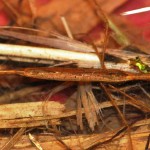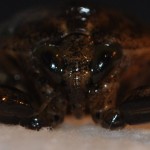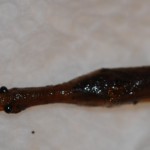If they weren’t such ferocious predators you might compare these guys to Laurel and Hardy. Common freshwater insects of ponds, marshes, and lakes these guys represent the big and tall end of invertebrate predators. But don’t look for laughs. Neither has a particularly comical side to its personality.
The long, narrow shape of the Water Scorpion makes it nearly impossible to see – until it’s too late.
Water Scorpions and Giant Water Bugs have something else in common – at either end of their fascinating bodies. Both insects are considered “Piercer Predators.” As the name implies they have a hardened beak at the end of their head which they use to pierce and kill prey. The giant water bug actually has the ability to inject enzymes similar to that of spiders for pre-digestion. Both use long forelegs to grasp their victims. And since both the water scorpion and the giant water bug have a tendency to hang upside down and wait for prey, each has a specialized breathing apparatus at the tip of the abdomen which extends just above the water surface.
Your ads will be inserted here by
Easy Plugin for AdSense.
Please go to the plugin admin page to
Paste your ad code OR
Suppress this ad slot.
The last thing you want to see if you are a small, or even large, freshwater animal – the voracious eyes of the Giant Water Bug.
But when it comes to predatory prowess the giant water bug truly is the master. In addition to those powerful forelegs that reach out, grab, and hold prey, the animal has four appendages outfitted with tiny hair like bristles adapted for swimming. They are very capable of chasing after and subduing food. And that food is just about anything it can grab; other insects, tadpoles, fish – nothing is safe from this monster. There are even reports of the giant water bug attacking and eating ducklings. And they will bite humans, too, if molested. They come by the nickname “Toe Biter” quite honestly. But as long as you refrain from placing a finger in front of that piercing mouth you have nothing to worry about. Giant water bugs can be handled safely when held by the rear part of that wide abdomen.
Water scorpions do not possess the power or swimming ability of their giant cousins. They prefer a more subtle method. Their preference is to hang unobtrusively from sunken vegetation or water grass and ambush smaller invertebrates. Their slender forelegs snap out and capture prey very much in the manner of the land living praying mantis. (Considering this and a distinct resemblance to walking stick insects it kind of makes you wonder where the “scorpion” part of their common name came from.) Stretched out amidst brown grass or dead leaves the water scorpion it is nearly impossible to see. Collectors often don’t even know that they have captured one until it moves.
Both of these insects are fascinating to observe and easy to catch. Do not, however, release the Giant Water Bug into an aquarium or a pond filled with your favorite fish. You will find out very quickly just how proficiently voracious they are.
HOOAH
Jack





Leave a Reply
You must be logged in to post a comment.